This (Antennaria dioica) is a common plant in the subalpine zone and in the lowland woods and higher up in the mountains too. You get it in different colors between red and white. The red ones are showiest.
Comments
Re: Don't forget the red ones!
So apparently, there is no longer a A. neglecta var. gaspensis, and A. gaspensis is A. rosea ssp. pulvinata, according to the USDA.
Personally, I like the bicolors best.
Antennaria rosea ssp. confinis
Re: Don't forget the red ones!
So apparently, there is no longer a A. neglecta var. gaspensis, and A. gaspensis is A. rosea ssp. pulvinata, according to the USDA.
Personally, I like the bicolors best.
Antennaria rosea ssp. confinis
Ooh, I like that one (A. rosea ssp. confinis), very nice :o. So, regarding the "gaspensis" thing, if I get a nice pink-flowered plant out of the NARGS A. rosea ssp. pulvinata seed, instead of the black-and white flowered "A. gaspensis" that was collected in Gaspe, all it means is that the lumpers have done some heavy lumping.
Re: Don't forget the red ones!
One that I grow in troughs because it stays small enough, is A. gaspensis (from the Gaspe peninsula, collected by George Newman), making a flat silvery ground cover, and while not showy it is interesting in flower, with blackish heads.
My geographical knowldge is dire so I had to look up the whereabouts of the Gaspe Peninsula in wikipedia!!
Perhaps others, especially non-North American readers might have the same curiosity so here is what it told me.....
"Gaspé Peninsula is a peninsula constituting part of the south shore of the Saint Lawrence River, in Quebec, Canada. It extends into the Gulf of Saint Lawrence and is separated from New Brunswick by the baie des Chaleurs and the Restigouche River.Gaspesie is a touristic region of Quebec.
The interior is rugged, being a northward extension of the Appalachian Mountains. This range is called the Chic-Choc Mountains. A section of the International Appalachian Trail travels along the peninsula. Route 132 circles the peninsula, with one branch following the coast and the other cutting across the peninsula at Sainte-Flavie. Forillon National Park is found at the northeastern tip of the Gaspé."
Re: Don't forget the red ones!
The Gaspe Peninsula is very much like the Northern Peninsula of Newfoundland...many of the plants are indeed the same except we don't have A. rosea! We have plenty of the brown Antennarias and a lovely one called Antennaria eucosma..the one in our BG is almost open.
In my garden red alpines are rare...here are two curently open. Primula auricula 'Dale's Red' is truly red! And I realize all of your Aquilegia canadensis bloomed weeks ago but mine are just starting.
Re: Don't forget the red ones!
Your 'Dale's Red is very red, Todd. This year I have managed to germinate lots of seed of A. canadense. I hope they are true!
I liked your black pussytoes, Mark, whether the name is this or that!
And your bicolored pussytoes, Rick, here the wild ones are either white (male plants, I am told) or red (female). I have to look out for bicolored, what kind of sex do they have?
Yesterday we had a nice trip in the mountains here (or rather the undulating "mesa". The highest point is 1200m and there were patches of snow all over. One of the few plants to flower was Loiseleuria procumbens.
Re: Don't forget the red ones!
Our Loiseleuria are blooming at the moment too....so Newfoundland is on par with the mountains of Scandanavia....yet our snow has been gone for 3 months....a testiment to just how cold this spring has been.
Re: Don't forget the red ones!
Our Loiseleuria are blooming at the moment too....so Newfoundland is on par with the mountains of Scandanavia....yet our snow has been gone for 3 months....a testiment to just how cold this spring has been.
The spring here has been colder than normal too, but not that cold!
Here's your weather forecast bay the way!
http://www.yr.no/place/Canada/Newfoundland/Saint_John%27s/hour_by_hour.html
Re: Don't forget the red ones!
Thanks for the link! Never saw this site..I now have it bookmarked. Today actually hit 19.4 C..the warmest day so far this year...mind you it was pouring rain!
Re: Don't forget the red ones!
Such a heat wave, Todd! We have finally gotten into the 90's...and kinda enjoy it...
Re: Don't forget the red ones!
Such a heat wave, Todd! We have finally gotten into the 90's...and kinda enjoy it...
Been there and done that in New England, a number of spring days to the mid 90's F already, with a boat-load of days in the mid 80s or more... our season as a result is so advanced, I'm sure its a record breaker.
Re: Don't forget the red ones!
Such a heat wave, Todd! We have finally gotten into the 90's...and kinda enjoy it...
That would be a little too hot for me!
Here's your weather forecast:
http://www.yr.no/place/United_States/Colorado/Hyatt_Regency_Denver_at_Co...
Re: Don't forget the red ones!
Thanks for the link! Never saw this site..I now have it bookmarked. Today actually hit 19.4 C..the warmest day so far this year...mind you it was pouring rain!
Hope it works for your place! It is fairly accurate for where I use it.
Re: Don't forget the red ones!
Gentlemen, you'll forgive me I hope, if I am less than enthusiatic to hear of your high temperatures.... I believe we may have hit the dizzy heights of 65 fahrenheit here in Aberdeen, Norht East Scotland----for an hour or two on a couple of days in the last few weeks---- but for the most part we get pleased if we make 55 at this time..... :(
Lovely photos of the Loiseleuria.... sometimes called the Trailing Azalea....... I LOVE this plant.....we have it in Scotland, too and it is one of our prettiest little plants, I think.
M.
Re: Don't forget the red ones!
Gentlemen, you'll forgive me I hope, if I am less than enthusiatic to hear of your high temperatures.... I believe we may have hit the dizzy heights of 65 fahrenheit here in Aberdeen, Norht East Scotland----for an hour or two on a couple of days in the last few weeks---- but for the most part we get pleased if we make 55 at this time..... :(
Lovely photos of the Loiseleuria.... sometimes called the Trailing Azalea....... I LOVE this plant.....we have it in Scotland, too and it is one of our prettiest little plants, I think.
M.
Here's your weather forecast!
http://www.yr.no/place/United_Kingdom/Scotland/Aberdeen/hour_by_hour.html
Re: Don't forget the red ones!
Here's your weather forecast!
http://www.yr.no/place/United_Kingdom/Scotland/Aberdeen/hour_by_hour.html
Yes.... see what I mean.... not exactly cheering for June, is it??!! ;D
Re: Don't forget the red ones!
Yikes, I'm struggling to come up with red too right now!
1) This particular plant of Castilleja miniata is near-red...
2) Does maroon-red count? How about Geranium phaeum 'Springtime'?
Re: Don't forget the red ones!
I am looking forward to see my Castillejas in bloom whether they are red or not! What do the cotyledons and first true leaves look like by the way?
I had Geranium phaeum 'Samobor' once but it has self sown in different colors. Can't say any of them are red - more brown and deep maroon.
Re: Don't forget the red ones!
I need to try a Castilleja...helps Lori that you live in the land of Indian paintbrushes!
Re: Don't forget the red ones!
Does Tropaeolum tricolor count? Not exactly in the Rock garden, but we do grow it outdoors and it's just started to flower - in the middle of winter.
cheers
fermi
Re: Don't forget the red ones!
I had this for several year as a pot plant. I am sorry it is not reliably hardy here.
Re: Don't forget the red ones!
In the garden of a friend of mine (Marsha Russell), she had scads of Anthyllis vulneraria coccinea; what an eyeful of blazing red color :o :o. I'm not sure about the true name of this color form, I have seen it listed as rubra and coccinea, but these must be illegal latinized cultivar names, because even though there are scads of varieties of Anthyllis vulneraria, I don't find a var. or ssp. coccinea anywhere. Marsha pulls out most of them each year, otherwise they'd probably take over the garden, but not to worry, they always come back from abundant self-sown seedlings.
IPNI.ORG search on Anthyllis vulneraria:
http://www.ipni.org/ipni/advPlantNameSearch.do;jsessionid=6864F48FB66FA0...
Re: Don't forget the red ones!
Anthyllis vulneraria is common on sandy soil many places in Norway, even in the mountains. Usually it is yellow or orange. I have never seen reds in the wild but I know the subspecies A. v. ssp vulneraria can be red. I grow both the red and the yellow form at my cabin in the mountains.
Re: Don't forget the red ones!
Here are some of my red flowered plants for the moment:
1) Lewisia cotyledon-hybrids are very popular here and seem to tolerate the winter wet. with reasonable drainage.
2) Phygelius capensis is often evergreen except the worst winters.
3) Rhemannia elata is monocarpic. It often flowers first year from early sowing but unflowered rosettes flower next summer.
Re: Don't forget the red ones!
Nice, Hoy!
I was very disappointed that Rehmannia glutinosa, supposedly very hardy (re. Rix and Phillips), did not winter over here for me.
This is decidedly orange, but it's the best I can do right now... Penstemon barbatus coccineus:
Re: Don't forget the red ones!
The Penstemon barbatus coccineus is red enough for me!
My contribution this time is not a flower but a kind of fruit, the unfertilized carpels of Paeonia mairei, here together with a Geranium sp from Himalaya.
Re: Don't forget the red ones!
How about a South African? Romulea sabulosa, can be grown in the ground here but I keep them in pots because of the cockatoos which have developed a taste for the corms!
cheers
fermi
Re: Don't forget the red ones!
This one was red! Looks a little like some tulips I have. Romulea don't do well here, too moist.
Re: Don't forget the red ones!
Here's the best I can do - not an alpine though - Silene regia, starting to bloom.
Re: Don't forget the red ones!
And that's not bad!
Re: Don't forget the red ones!
What I can do for the moment is this Centaurea scabiosa with butterfly (Aglais urticae) and a bumblebee (Bombus sp).
The Centaurea is actually a lowland plant but it does very well at our cabin in the mountains tolerating night frost and flowering late and till it is covered by snow. It even manage to set ripe seed some years. All kind of insects are drawn to the nectar rich flowers.
Re: Don't forget the red ones!
Lori, Silene regia is a HOT ONE! I wasn't familiar with this native, now my eyes have been opened... Hot Cha Cha cha!
Get ready for retina burn with Zauschneria garrettii (or Epilobium canum ssp. garrettii as now known). This grows luxuriantly, two plants are now about 3-4' across each (and 12" height), the spread more than I anticipated for, thus swamping other plants. But I will move it to a place where is can spread comfortably, as it is so worth growing for the late season burn of red-orange flowers. Most years, it makes a "smattering" of those lovely red-orange trumpets, but this year, perhaps due to the long sizzling dry summer, it looks to be a banner year for bloom.
First, a photo showing its expanse of growth, just breaking into bloom among late summer blooming alliums. Second photo shows a closeup with more flowers open. I'll post again in a week or so, should be its most floriferous year yet.
Re: Don't forget the red ones!
I don't get retina burn, Mark, but I taste it! It's like chili pepper - and not the bad one.
I tried Zauschneria once but lost it. Have to try again.
Re: Don't forget the red ones!
One of the reddest here now is this Crocosmia cultivar. I don't know the name. Crocosmia are one of the genera thriving and expanding and often divided and given to garden friends. I got this one without a name.
Re: Don't forget the red ones!
Not alpine, and not a flower... but the fleshy seeds of Euonymus nana var. turkestanica are red!
Re: Don't forget the red ones!
Long ago, before I realized the diversity in Euonymus fall shows, I grew Euonymus nanus var. turkestanicus. The rabbits kept eating them down so I never saw the capsules and seeds. I just couldn't figure out what the allure of this plant was. That is, until the year it actually did flowered and produced capsules and seeds. Of course, I was immediately smitten, and I still grow the shrub.
Fortunately, I am far enough west so the members of this clan are not invasive (although I always keep a watchful eye), and I have since delved into the genus. My favorite so far is the pink and red Valentine colors of E. hamiltonianus var. sieboldianus (more so than turkestanicus). However after ten years, the shrub is becoming more tree like, and I don't want to allow space for that. The image below was taken in 2008. It is the second species with capsules to color up in the fall for me. The warty stems and brown flowers of E. verrucosus are attractive, at least to me. The pic is pretty terrible: the flower color is caramel with a hint of pink. I obtained seed of Euonymus cornutus var. quinquecornutus this year, but I don't think anything emerged yet. I save all my planted seed pots for at least two years, so I will see what happens.
Re: Don't forget the red ones!
Not alpine, and not a flower... but the fleshy seeds of Euonymus nana var. turkestanica are red!
Hello fellow Euonymus fans! Just started to post, and Rick's message came in. Rick, you show a couple new ones I didn't know about, but nice tempting ones they are! I bought my plant originally as E. turkestanica nana, although based on what I'm finding on the web, it should perhaps be the other way around, often seen as E. nana 'Turkestanica'. Checking out IPNI.ORG, I can't find any valid entry for Euonymus nana, nor E. turkestanica! There is however a Euonymus nanus and a E. nanoides, although web searches indicate a Euonymus nanus turkestanica, so E. nanus is probably the correct species name.
My plant was grafted on top of a standard, as the type plant is supposed to be a low sprawling plant. I saw this in a nursery two years in a row, finally succumbed and bought it for a ridiculous high price. It lived several years in the garden, making a surprisingly good floral show (see photo), the flowers bright red rather than yellowish-green as so common in the genus, and then the familiar hanging pods, pink in this case, opening to red-orange seeds. It succumbed I believe to to drought, but that is drought to the grafted understock, not necessarily to the type E. nanus.
The one that I'm really a fan of is Euonymus sachalinensis, a small tree. I saw this at the Case Estates in Weston Massachusetts, a now defunct outpost of the Arnold Arboretum, where it was in espalier form, trained and pruned to best show off the amazing bounty of fleshy red pods and brilliant red-orange seeds. It has gotten very late, but I promise to show E. sachalinensis, one of the very best and showiest of the bold-fruiting Euonymus species.
Re: Don't forget the red ones!
Who is our Botanical Latin "specialist" here? As I understand, euonymus would be masculine, or possible neuter. How can nana or turkestanica (both feminine adjectives) be in gender agreement? My Stearn's book seems to be misplaced, not that I would necessarily get it, anyway.
E. sachalinensis does ring a bell in the back of my mind as one I have come across in literature, and worthy of ferreting out. Mark, I though Euonymus spp. were no-nos in you neck of the woods?
Re: Don't forget the red ones!
E. sachalinensis does ring a bell in the back of my mind as one I have come across in literature, and worthy of ferreting out. Mark, I though Euonymus spp. were no-nos in you neck of the woods?
The overly used burning bush, Euonymus alatus, is now considered an invasive species, and in 2009, added to the Massachusetts Prohibited Plant List (http://www.mass.gov/agr/farmproducts/proposed_prohibited_plant_list_v12-...). There are many other Euonymus species that are potentially as gregariously spreading but they are not on the list, only because they are lesser known species. I do in fact get lots of self-sown seedlings on E. sachalinensis.
Re: Don't forget the red ones!
ITIS claims that Euonymus nana is an "accepted" name, but it seems to be in the minority. http://www.itis.gov/servlet/SingleRpt/SingleRpt
I've seen a site that claims "turkestanica" to be a cultivar (not a variety, as I had thought).
At any rate, I'll correct my records - thanks!
Those are attractive plants, Rick and Mark - thanks for posting. Euonymus are not (yet?) on the invasive weed list here, and I have not yet noticed one as an escape.
Re: Don't forget the red ones!
Who is our Botanical Latin "specialist" here? As I understand, euonymus would be masculine, or possible neuter. How can nana or turkestanica (both feminine adjectives) be in gender agreement? My Stearn's book seems to be misplaced, not that I would necessarily get it, anyway.
I am by no way an expert in this matter, but you are right, Rick. I think Euonymus is masculine and hence it's nanus, not nana. According to RHS's New Dictionary of Gardening the correct name is Euonymus nanus 'Turcestanicus'.E. sachalinensis does ring a bell in the back of my mind as one I have come across in literature, and worthy of ferreting out. Mark, I though Euonymus spp. were no-nos in you neck of the woods?
E. sachalinensis is synonymous with E. planipes. It is a common garden shrub here although I don't grow it but E. europæus. Another fine Euonymus is E.alatus. The last one has insignificant flowers and fruits but the twigs and the autumn color is outstanding.
All the pics are from last fall (October or November).
E. europæus selfsow a little and I have to remove seedlings every spring.
Re: Don't forget the red ones!
One more red, or nearly so. Anemone hupehensis has a kind of red flowers, especially if seen from behind.
Rick, the Euonymus verrucosus is very interesting. Does it set viable seed? Can I ask for some if possible?
Re: Don't forget the red ones!
One more red, or nearly so. Anemone hupehensis has a kind of red flowers, especially if seen from behind.
Rick, the Euonymus verrucosus is very interesting. Does it set viable seed? Can I ask for some if possible?
All fall-blooming Anemones fried to a crisp this summer, so no flowers this year, hopefully the plants survive. I don't grow the hybrids, but only A. tomemtosa, maybe to see it another year.
As to various Euonymus, not sure you caught my comment, but Euonymus alatus is banned and is one the State of Massachusetts Prohibited Plant List due to its invasive spreading by seed. I believe it is similarly banned from a number of US States.
Re: Don't forget the red ones!
The pic is of E. verrucosus in a pot. I would have planted it out in the yard last fall or spring, but a rabbit ate it down to a nub last September. It had two unripe capsules at the time. I am sure they were very yummy, as were the Styrax americanus seedlings grown from the disjunct population in Illinois. Out of my hundreds of pots, those were the only two the rabbit ate. :-[ I guess I should be happy that was all he ate!
Anyway, both have rebounded nicely, and E. verrucosus will find itself in a landscape berm next year. So I expect flowers (and seed) next year, and I'll keep you in mind, Trond.
Re: Don't forget the red ones!
Anyway, both have rebounded nicely, and Euonymus verrucosus will find itself in a landscape berm next year. So I expect flowers (and seed) next year, and I'll keep you in mind, Trond.
Me too please. Looks like I'll have a bumper crop on Euonymus sachalinensis, let me know if anybody wants some.
Re: Don't forget the red ones!
Get ready for retina burn with Zauschneria garrettii (or Epilobium canum ssp. garrettii as now known)...
Most years, it makes a "smattering" of those lovely red-orange trumpets, but this year, perhaps due to the long sizzling dry summer, it looks to be a banner year for bloom.
It's definitely not a banner year for it here, with so little warmth! Looks like I'll only get a very small smattering of bloom. (On the other hand, at least it's blooming, while so many other perennials chose not to bloom at all this summer.) It is usually a very good late-bloomer here, going well into October, weather permitting.
The second photo shows the allegiance to Epilobium quite clearly.
Re: Don't forget the red ones!
E. sachalinensis is synonymous with E. planipes. It is a common garden shrub here although I don't grow it but E. europæus.
E. europæus selfsow a little and I have to remove seedlings every spring.
Trond, I missed commenting on Euonymus europaeus... that's quite a display of seed capsules. In a way, it is better than E. sachalinensis in that it displays the fruit without leaves apparently, so more of an impact, whereas in E. sachalinensis the "fruits" can be partially obscured by the foliage.
Now, checking into the issue of E. sachalinensis being a synonym for E. planipes, I believe the situation is a little different. Some sites suggest that plants in Horticulture are in reality E. planipes, and that the true E. sachalinensis is not in cultivation, or rarely so.... most plants actually being E. planipes. However, both planipes and sachalinensis are valid species. The following site says that E. planipes has green flowers, whereas true sachalinensis has brown flowers, so it looks like I have E. planipes if this is true.
http://www.rogerstreesandshrubs.com/gallery/DisplayBlock~bid~9980~gid~~s...
This site says E. sachalinensis has green flowers, mentions E. planipes, but doesn't address the nomenclature or identification issue.
http://en.sl.life.ku.dk/faciliteter/arboretet/maanedensplante/2004/oktob...
And then some sites put it the other way around, E. sachalinensis (syn. E. planipes), and yet other sites say about E. planipes: possibly not distinct from E. sachalinensis? So which is it?
===============================================
More googling, and one can read the species descriptions of E. sachalinensis and nanus in this Flora of China PDF on the genus Euonymus. E. sachalinensis does have reddish to purple or brown flowers, so my plant can't be sachalinensis, and E. nanus has whitish-green flowers... so my plant that had red flowers was also misidentified. In Flora of Japan, E. planipes is described as havingflowers that are white to pale green... my plant is most likely E. planipes.
http://flora.huh.harvard.edu/china/PDF/PDF11/Euonymus.pdf
Re: Don't forget the red ones!
Mark, some want to split and some want to merge species! That's normal. I cited RHS's Encyclopedia.
Re: Don't forget the red ones!
It's definitely not a banner year for it here, with so little warmth! Looks like I'll only get a very small smattering of bloom. (On the other hand, at least it's blooming, while so many other perennials chose not to bloom at all this summer.) It is usually a very good late-bloomer here, going well into October, weather permitting.
The second photo shows the allegiance to Epilobium quite clearly.
You are luckier than me though, Lori. I have never succeeded with Zauschneria regardless its name.
Re: Don't forget the red ones!
You're on the list too, Mark, for verrucosus. If all goes well, I think it might be easier for you to root cuttings next summer. That's how I propagated mine. Likewise, I thought it might be easier for me to root cuttings of planipes, but Dirr only lists propagation from seed for sacalinensis so I'll stick with that for now. Yes, I'd like to try some seed, with a few different methods of preparation. Euonymus seed have a very oily coating, and some sources recommend washing in diluted soap first, although Dirr does not mention it.
Re: Don't forget the red ones!
You're on the list too, Mark, for verrucosus. If all goes well, I think it might be easier for you to root cuttings next summer. That's how I propagated mine. Likewise, I thought it might be easier for me to root cuttings of planipes, but Dirr only lists propagation from seed for sacalinensis so I'll stick with that for now. Yes, I'd like to try some seed, with a few different methods of preparation. Euonymus seed have a very oily coating, and some sources recommend washing in diluted soap first, although Dirr does not mention it.
I'll get plenty of seeds later on europæus, if it is of interest. They germinate easily under the mother plant every year. However, I do not know if the seeds are 1, 2 or more years old when they decide to germinate.
Re: Don't forget the red ones!
Looks like I'll have a bumper crop on Euonymus sachalinensis, let me know if anybody wants some.
Mark,
just as well it's also known as E. planipes as it's allowed into Oz under that name! (Yes, please!)
I took these pics before the sun came out so the flowers aren't open fully but quite obvious red! Anemone pavonina - even the white ones have red exteriors. :D
And Tulipa greigii (possibly "Red Riding Hood") is certainly bright in the spring garden.
cheers
fermi
Re: Don't forget the red ones!
A little red darling!
Does it open wide, or stay fairly closed?
Re: Don't forget the red ones!
A little red darling!
Does it open wide, or stay fairly closed?
Hi Rick,
if you mean the anemone, yes it does, but only in full sun and not at 7am!
Actually, the tulip does the same, too!
cheers
fermi
Re: Don't forget the red ones!
A little red darling!
Does it open wide, or stay fairly closed?
Taken at 8am this morning,
Tulipa greigii and Anemone pavonina,
cheers
fermi
Re: Don't forget the red ones!
Nice to see spring plants at this time of the year - the rain is pouring down outside!
Re: Don't forget the red ones!
Here, pushing things right to the limit, is Ipomopsis rubra... In a few fitful previous tries, I was never able to winter it over, but now finally, success... However, this bit of bloom is all I'll get, since it's getting very late, and this biennial will definitely not be able to set seed before it's killed by the cold. (Grrr, I remember again why I hate biennials! ::))
The second photo does shows the frost-bitten flowers looking very red...
Re: Don't forget the red ones!
Ipomopsis is a genus that I have not considered trying, but I think I will now!
What's the trouble wintering it over - frost, humidity, lack of warm summers?
Re: Don't forget the red ones!
Here, pushing things right to the limit, is Ipomopsis rubra... In a few fitful previous tries, I was never able to winter it over, but now finally, success... However, this bit of bloom is all I'll get, since it's getting very late, and this biennial will definitely not be able to set seed before it's killed by the cold. (Grrr, I remember again why hate biennials! ::))
Lori, I love these things, the Ipomopsis (or Gilia, as I used to grow them under). I've not grown I. rubra, and when I look it up on the USDA site, I can't believe my eyes on it's distribution... it even includes little ol' Massachusetts! Since the distribution includes Michigan and Ontario, I have to assume some strong level of hardiness. I had always thought of this as a strictly southern species, or a Texas wildflower, shows what I know ;-)
http://plants.usda.gov/java/profile?symbol=IPRU2
I wonder if you might be better off growing I. aggregata or one of its many subspecies, this being the Western version of rubra... perhaps you already grow that one.
http://plants.usda.gov/java/profile?symbol=IPAG
Years ago I used to grow several color forms, and even a few other species from Sally Walker's Southwestern USA collected seed, and the first year biennial rosettes were not only flat, lacy, and tinged with color, they seemed perfectly hardy, and quickly grew the following year with bright display of red, purple, pink, and white.
Re: Don't forget the red ones!
Ipomopsis is a genus that I have not considered trying, but I think I will now!
What's the trouble wintering it over - frost, humidity, lack of warm summers?
With I. rubra, I had assumed it was not hardy enough, but it may have been ignorance on my part... planting them in unsuitable conditions perhaps with too much competition for the first year rosette (whereas this one was on a slope in the front yard - better drainage, full sun, no competition)? I guess I'd have to try them a few more times to know.
I wonder if you might be better off growing I. aggregata or one of its many subspecies, this being the Western version of rubra...
I grew I. macrosiphon which was fantastic... but unfortunately didn't reseed:
http://nargs.org/smf/index.php?topic=69.0
Re: Don't forget the red ones!
I will look for any seeds (of this genus) when I get the seedex list!
Re: Don't forget the red ones!
If I. rubra can survive in mass, then I might have a chance here...I have it on my list for the NARGS seed order...I will even overwinter one in a coldframe for a chance to get blooms...it is VERY impressive!
Re: Don't forget the red ones!
Alstroemeria angustifolia grows well in our rock garden and spreads gently.
cheers
fermi
Re: Don't forget the red ones!
I'm always looking for cold-hardy, easy-care, red-flowering species for my high-altitude (10,000 feet) gardens in the Colorado Rocky Mountains. One of the most stunning species that has decided to grow and prosper far from its native home of west-central New Mexico is Silene laciniata (Indian Pink). As its species name implies, its petals are deeply cut, or lacinated.
In the wild, it stands about 8 to 12 inches and seems to prefer the rather dry, acidic soil under lodgepole pines in partial shade. Most of the population my husband Klaus discovered and photographed in a campground near Luna, New Mexico was the typical vibrant red. But there were also some delicate, baby-pink specimens. (By the way, the common name "pink" does not refer to the color but to the "pinked" look of the petals of many species within Silene's family (Caryophyllaceae) -- as if someone cut them with pinking shears.) Photo #1 is a typical, few-flowered, red-blossomed plant in the wild. Photo #2 shows the pink variation.
Experimenting with this wild species in my gardens, I discovered that it does best in my artificial bog garden! This was certainly unexpected. However, the seedlings I located in drier soil, similar to that in their native ecosystem, suffered terribly. Some died before I got the idea to try the bog. The lucky ones established in that moist, heavy soil in light shade from a lodgepole pine and every year produce a floriferous display of bright red blossoms in mid-August to mid-September (about the same bloom time as in their native land which is at about 7,500 feet elevation). Unlike the wild specimens, my garden-grown plants stand 18 to 20 inches tall and have a spread of abount 18 inches with numerous flowering stems. Photo #3 shows a garden-grown specimen.
Unfortunately, the late blooming of this species means a very sparse seed crop. Most years no seed is produced before the garden is buried in snow, which can be as early as mid-October.
Re: Don't forget the red ones!
Jane, its a stunning Silene to be sure; I grew it 25 years ago or more, and haven't tried again since then, it did flower in that screaming vermilion color. I like how the calyxes are also vibrant red, adding to the floral effect, most noticeable in your 3rd photo. The pink one is a rare find, might you introduce it as Silene laciniata 'Luna'? :D
Glad you added the cultural note, I would not have imagined that it would do well in an artificial bog situation, but it sounds from your experience that the plants do benefit from a more regular source of moisture... duly noted. In passing reference you note the late flowering of this plants make seed set a challenge, just how late in the season does this plant bloom for you? I'm always looking for late blooming rock plants, so this might be a good candidate. Have you seen my post on a very late blooming Saponaria (S. cypria) here: http://nargs.org/smf/index.php?topic=325.0
@Fermi: how hardy might Alstroemeria angustifolia be, and how tall growing is it? Beautiful colors on that one.
Re: Don't forget the red ones!
Fermi, those red Alstroemeria is wonderful! It seems too to be reasonably tall. I grow only A aurea and that one gets taller and the color is not so good (now I wonder how it has taken the hard frost this winter).
Jane, Silene laciniata is a plant I have admired in pictures but never managed to germinate although I have several attempts. Are the seeds ephemeral or needing special treatments?
Re: Don't forget the red ones!
Mark,
Silene laciniata blooms at my 10,000-foot elevation from mid-August to mid-September. New Mexico has a late-summer monsoon season that induces blooming in a large number of unrelated species. Some years ago, Panayoti wrote an article in the NARGS bulletin about that situation. Where I live in Colorado, we don't have that late flowering season. Our native species are pretty much done by early August. You can still find flowers in bloom here and there but not in profusion as you would in late June to about mid-July. Introducing species from a similar conifer-forest ecosystem in New Mexico has enable me to extend the period of full color in the gardens into early October.
Trond,
No, the seeds are not ephemeral and, as I recall, I did not stratify them. I started them indoors at about 60 degrees F. I'm guessing they probably germinated in two to three weeks. This species produces a very thick, deep taproot so decide where you want it to grow outdoors and then don't plan to move it after it gets to be about 3 or 4 years old.
Re: Don't forget the red ones!
Mark,
Silene laciniata blooms at my 10,000-foot elevation from mid-August to mid-September. New Mexico has a late-summer monsoon season that induces blooming in a large number of unrelated species. Some years ago, Panayoti wrote an article in the NARGS bulletin about that situation. Where I live in Colorado, we don't have that late flowering season. Our native species are pretty much done by early August. You can still find flowers in bloom here and there but not in profusion as you would in late June to about mid-July. Introducing species from a similar conifer-forest ecosystem in New Mexico has enable me to extend the period of full color in the gardens into early October.
Trond,
No, the seeds are not ephemeral and, as I recall, I did not stratify them. I started them indoors at about 60 degrees F. I'm guessing they probably germinated in two to three weeks. This species produces a very thick, deep taproot so decide where you want it to grow outdoors and then don't plan to move it after it gets to be about 3 or 4 years old.
Thanks, Jane! If I ever get seedlings I will remember what you say!
Re: Don't forget the red ones!
Here's another stunning red-flowered species that's easy to grow: Anemone coronaria (Poppy Anemone). It is listed as hardy in Zones 7-10 and as an annual in my Zone 4 but I have 3-year-old flowering plants that I grew from seeds purchased from Chiltern Seeds (U.K.). The usual way gardeners grow these beauties is from purchased tubers in fall in warmer zones and in spring in colder zones. I, too, often plant tubers in spring. The plants grown from seed bloom in early July; those from spring-planted tubers, in mid-August to early September. Although the literature says this species is hardy to only 28 degrees F., it gets colder than that at night in late August and certainly in early September but my plants and their flowers have not exhibited any frost damage. While the seed-propagated plants return every year (so far), the tuber-propagated ones do not.
They are available in separate colors of red, pink, white and purple in fall but usually only in a mix of colors if purchased in spring. Seeds are abundantly produced and are easy to germinate (no stratification needed). The plants vary in height from just 8 inches tall to 18 inches tall. They are happy in full sun or light shade in dry to evenly moist soil of low to high fertility. In other words, I plant them wherever I find room and they grow!
Re: Don't forget the red ones!
Jane: you have GOT to be kidding me: you have grown Anemone coronaria in THE BLUE RIVER VALLEY? That's amazing.
I guess I should start planting out coconut palms in Denver then!
Re: Don't forget the red ones!
Anemone coronaria is a lot hardier than one would think. I have had them winter over here in zone 3, although they never amounted to much in the second year (foliage, no flowers).
Re: Don't forget the red ones!
The latest red flowers in the Rock Garden, Rhodophiala bifida,
cheers
fermi
Very nice Fermi, I would love to have Rhodophiala blooming in my garden!
Re: Don't forget the red ones!
Color is certainly subjective. I find it interesting in the Flora of China, not sure if it is a translation issue or not, that pink flower color is invariably listed as "pale red". Going back to Antennaria, for most of the deeper color forms of A. rosea and A. dioica (including the nice one you show Trond) I would call them pink; a nice bright or rich pink, but definitely pink. There are some selections that, repeating my previous characterization, "approach" red.
I think the genus Penstemon has some interesting cases, such as with the shrubby Dasanthera species, where flower color traverses the pink to red spectrum. I hear people describe the flowers on Penstemon rupicola as red, or "cherry red", but to me they are definitely a rich pink. http://calphotos.berkeley.edu/cgi/img_query?enlarge=0000+0000+0809+1902
Penstemon newberryi has several forms, often the flowers are a rich intense pink, or "rose-red", but there are some true pure red flowered forms. Bob Nold's book on Penstemon mentions a cultivar of P. newberryi named 'Red Lassen' offered by Siskiyou Rare Plant Nursery; a cherry red selection. I once grew a form of Penstemon newberryi ssp. sonomensis from seed that had amazing blood red flowers, not pink in the slightest. Googling around, I found another cultivar at Yerba Buena Nursery named Penstemon newberryi sonomensis 'St. Helena'.
http://www.yerbabuenanursery.com/viewplant.php?pid=1503
http://www.yerbabuenanursery.com/images/new_botimages/large/1503_j.jpg
The CalFlora site has some nice photos Penstemon newberryi ssp. sonomensis, they look decidedly red. The subspecies is notoriously fussy in cultivation, but who wouldn't want to grow this beauty.
http://calphotos.berkeley.edu/cgi-bin/img_query?rel-taxon=contains&where...
http://calphotos.berkeley.edu/cgi/img_query?enlarge=0000+0000+0509+2901
Re: Don't forget the red ones!
Mark, Penstemon rupicola even I would call pink (or "rosa"). The P newberri cvs shown are red, as stated.

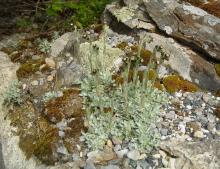
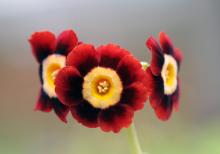
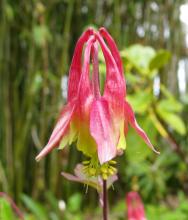
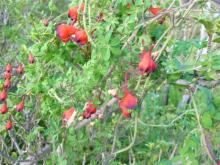
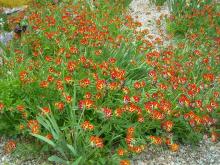
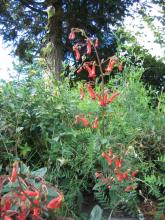
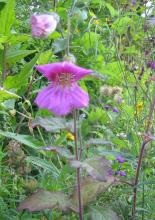
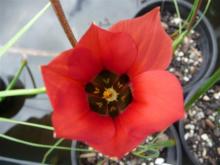
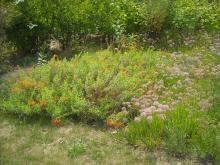
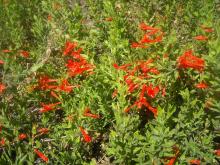
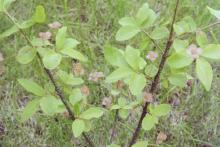
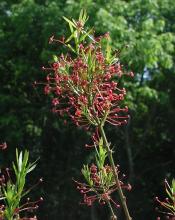
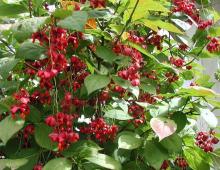
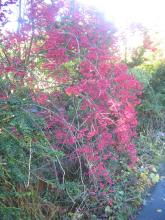
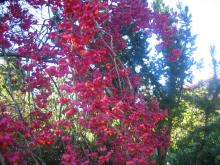
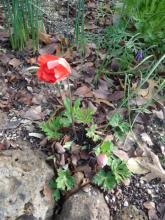
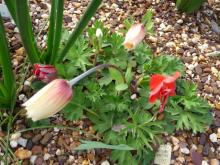
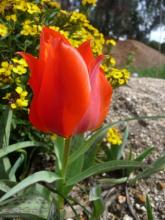
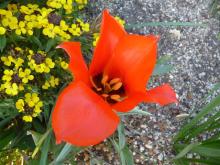
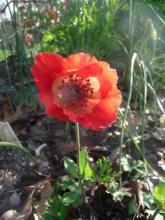
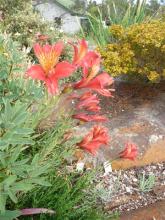
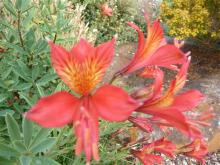
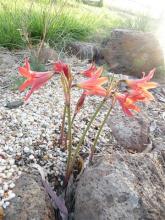
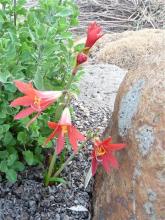
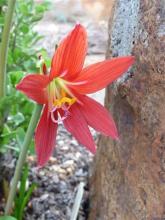
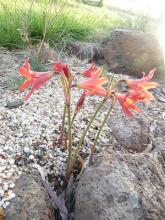
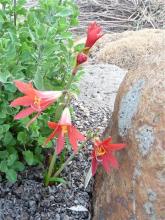
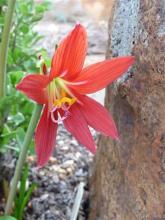
I really like Antennaria, after all, it's my namesake for my two email addresses. There are some very good species and forms, and yes, I too like the more colorful forms. One that I grow in troughs because it stays small enough, is Antennaria gaspensis (from the Gaspe peninsula, collected by George Newman), making a flat silvery ground cover, and while not showy it is interesting in flower, with blackish heads. However, like many pussytoes (who doesn't like a plant with a cute common name like that) the flowering stems elongate and flop and entangle themselves, looking quite unkempt. Which reminds me, time to go out with a sharp pair of snips and cut those ugly stems off before all the "fluff" starts shedding.
I had germination on one called Antennaria rosea ssp. pulvinata from NARGS seed this year, listed as cream, pink or rose, 4-17 cm. Checking out the USDA data page on it, it has a huge array of synonym, with A. gaspensis included! Recent taxonomic revisions have taken the approach of massive lumping. It'll be interesting to see how it compares to A. gaspensis
http://plants.usda.gov/java/profile?symbol=ANROP
Ooh, look at this one, Antennaria corymbosa,
Antennaria corymbosa E.E. Nelson - flat-top pussytoes
http://plants.usda.gov/java/largeImage?imageID=anco_003_ahp.jpg